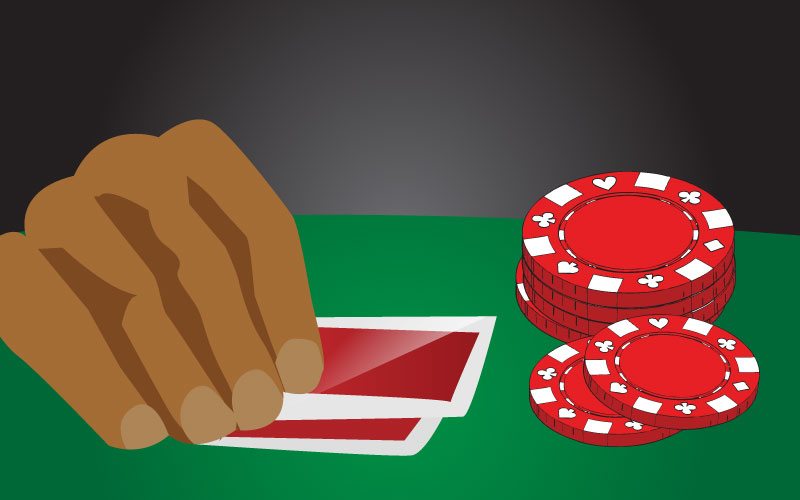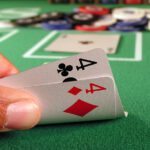Continuing with examples…
Example 2 – Betting Draws for Value
We are on the button in a standard loose-passive game. 4 players limp to us and we have KhQh. What should we do?
Answer – raise. Again, even though we are behind Ax and small pairs, a hand like KQ suited plays so well multiway that we need to raise here for value. With 4 other players in the hand and the BB likely to call close to 100% of the time, that means that we are basically guaranteed to have 6 players in the hand. As long as our hand has more than 16.6% equity (1 in 6), then we should raise. KQs has well over the 17% equity we need 6 handed versus wide ranges. If you don’t believe me then pokerstove it yourself. We raise here because we have a pot equity edge and we want to maximize it. The fact that we will lose with our hand over 75% of the time does not mean that we should not raise with it.
Both the SB and the BB call our raise as well as the remaining 4 limpers (which we expected and is why we raised). So on the flop we are 7 handed and the pot has 12.5 SBs.
The flop comes 4hThJs. The SB who plays almost every hand preflop, but does not lead out postflop unless he has top pair and a good kicker or better, leads out. 3 players call, 2 players fold, and it comes to us on the button. The pot is now 5 handed and there are 16.5 SBs in the pot. What should we do?
Answer – raise for value. We know that we are behind the SB right now, but we don’t care because our draws are so good. We have 9 outs for the flush, and 6 more outs for the open end straight draw (we only have 6 instead of 8 outs for the straight because we can’t count the Ah and 9h twice), and it is possible that our K and Q will still win the pot for us if they were to hit as well. Because it is also possible that someone has the nut flush draw and it’s possible that we are drawing dead with the K and Q outs, I will be conservative and say that we have only 15 outs. But 15 outs will win the pot over 50% of the time (from our outs times 2 per street rule we know that a 13 out hand on the flop wins right around 50% of the time by the river). So we want to raise here for value. Even if the worst outcome happened and the SB was to 3-bet and show everyone that he had flopped a set of tens and all the other players folded, we would still be fine with that result because we would still have about 40% equity in a huge pot which we had contributed well less than 40% into.
We raise, the SB calls, and the 3 other players call as well. The pot is 5 handed and has 22.5 SBs which means it has just over 11 BBs on the turn. The turn is the 8d. The board now reads 4hThJs8d. Everyone checks to us. What should we do?
Answer – Bet. The first thing we do is figure out where we are at in the hand. The SB just calling our raise on the flop and then checking this turn likely means that s/he had a hand like AJ or KJ rather than 2 pair or better because he likely would have 3-bet those on the flop. He still could have 2 pair and have been scared that we have a set, but we shouldn’t be overly concerned about that. We also know that someone could have hit a straight with Q9 or 97 at this point and with just K hi we don’t have the winning hand right now. But with 4 other players in the hand and with our still current 15 outs we should still bet here. Betting serves two purposes: 1) it maximizes our value when we do hit our hand because it adds bets into the pot – with 15 outs we know we have about a 30% chance of hitting our hand on the river using the outs times 2 rule; so as long as 4 players call our bet then betting here is correct because we have a pot equity edge; 2) betting could easily get a better hand to fold and can increase our likelihood of winning the hand if a K or Q hits – if we check here it allows everyone to stay in the pot for free; but if we bet we can get hands like AK, AQ, TQ, and TK to possibly fold. If we bet and get those hands to fold now, we win when a K or Q hits the river. If we check and allow those hands to stay in, we lose to them on the river.
No matter what happens at this point we know that we have played our hand correctly. If we bet and someone raises then we just call and hope to hit our flush or straight. If we bet and everyone calls, then we just check back the river unless we hit one of our outs. If we bet and hit our straight or flush, then we bet again on the river. The point here is that in multiway pots, when you have a pot equity edge, you need to keep betting even if you don’t have a made hand. So with huge draws in position you want to keep betting. Betting maximizes value, and it gives your opponents the opportunity to fold a better hand.
Submit your review | |









